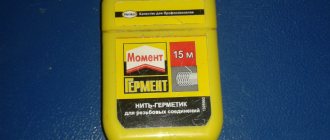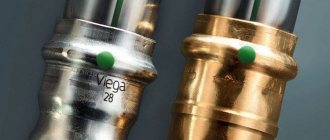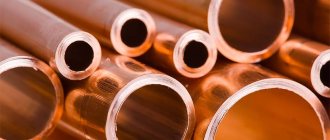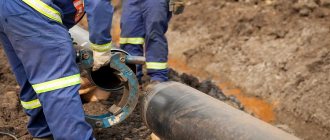Have you noticed how many different ways experienced craftsmen can offer to solve the same problem? The construction of a gas pipeline is no exception. Thus, the connection of gas pipes by professional gas workers is carried out using different materials and techniques. The craftsmen's arsenal includes carving and welding, soldering and flanges. They actively use techniques that have been proven for decades and those that have recently emerged.
Knowing the basic methods, understanding the tools and modern materials, it is easier to track the correctness of the work and monitor the actions of invited specialists.
In this article we have described the main options for fastening gas pipes and methods for sealing joints. After reading it, you will understand the types of pipes, the characteristics of materials, and the technologies for working with them. We paid special attention to methods for checking connections that have already been made, since the safety of operation of household gas equipment depends on their correctness.
Linen
Linen strands or flax complete with lead lead on drying oil in our country is the most famous and popular method of sealing pipe joints.
With the help of flax strands, both gas and water pipes are installed in most apartments and houses. Largely due to the fact that this is spelled out in SNiP. Sometimes, instead of lead lead, its iron counterpart is used, but it has a clear drawback - the lack of protection against rust. In some cases, the red lead is completely neglected and the connection is established without it. This significantly increases the likelihood of corrosion developing in threaded connections.
Sealing pipe joints with flax has a number of undeniable advantages:
- Availability and low cost.
- High level of adhesion after drying oil has dried.
- Strong fixation due to high forces when tightening the connection.
However, this outdated sealing method has many disadvantages:
- To install pipes correctly, you need to have professional knowledge.
- Using too much thread tightening force may damage the part.
- Over time, gas or heating systems may begin to leak due to the destruction of the flax structure, so repairs to the system must be carried out on time.
- Difficult dismantling. It is often necessary to heat up the compounds until the flax burns out.
Thus, using flax for sealing is fraught with some problems, but with good reliability it will allow you to save on purchases.
Methods for checking the tightness of connections
The tightness of the gas pipeline is checked in sections. In a situation with apartment buildings, a segment is selected from the point of fuel entry into the building to the taps of household equipment.
Plugs are placed at the ends of the section. The pressure in the pipes exceeds the standard values by 25%. A drop in pressure is a reason to check connections.
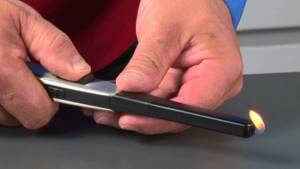
It is forbidden to check gas leaks using open fire: matches, candles. Lighters and piezo lighters are not suitable for this purpose. Fuel accumulated near the connection may explode
The integrity of joints, branches and equipment connection points is checked in two ways:
- Using a gas leak indicator.
- By applying a soap solution or emulsion.
In the first case, a digital, sound or color signal from the device will notify you of the danger. In the second, you need to monitor the appearance of bubbles. Their presence indicates a violation of the integrity of the connection.
Non-hardening pastes
This type of sealant is a reliable and inexpensive way to prevent the possibility of leaks. The material itself is quite easy to install. Non-hardening pastes are a viscous substance based on oils, synthetic resins and fillers. It is worth noting that this material can only be used for low pressure pipes and gas pipelines.
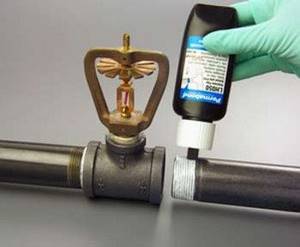
Advantages of non-hardening pastes:
Easy to install, you just need to lubricate the thread surface.
- Easy to tighten.
- Easy dismantling of the system.
Now let's move on to the disadvantages of this material:
- At high pressure, the sealing material is gradually squeezed out of the threaded connection.
- Only seals well at low pressure connections.
- Cannot be used with small thread gaps.
- There is no strong fixation of the connection.
So, we can conclude that non-hardening pastes are a good method of sealing, they are reliable and will not break your wallet, but are only suitable for low pressure systems.
Gas pipe connection options
Today, craftsmen distinguish 5 types of connections when installing a gas pipeline. These are welding, used for metal pipes, soldering, used for copper and PVC, tapping, threaded and flanged connections.
Option No. 1 - welded seam
Steel pipes are processed using an inverter or gas welding equipment. The ends to be connected are placed at a distance of 1.5-2 mm from each other and firmly fixed.
During the process of melting metal, the welder places two seams: the main one and an additional safety one.

Experienced craftsmen cool the heated metal and only then get rid of scale. This makes it possible to avoid the appearance of cracks
The polyethylene elements are joined with a device that controls the temperature achieved during heating. A fitting with a consumable element is used for connection. By heating the surrounding material, it turns the mixture into a homogeneous mass. The result is a sealed, durable seam.
Option No. 2 - soldering pipes
Butt soldering is suitable for both metal pipes and thermoplastic polymer products. The work is performed on a modular unit, including a hydraulic unit, a centralizer, a soldering iron and a built-in cutter.
The algorithm is as follows:
- The ends of the elements to be soldered are cleaned of chips, dust, and foreign particles. Degreased.
- Using a soldering iron for polypropylene pipes, the parts are heated and brought closer together until a 1 mm thick bead appears on the joint surface.
At the end of the work, the connection is left in the unit until it cools completely. Any movement during a period of decreasing temperature can cause fistulas.
Option No. 3 – insertion into a pipe
Insertion is a method that requires special qualifications. It can be performed hot, in which an arc welding unit is used, and cold, when the main tool is drilling equipment.
The point of the manipulation is to organize a sealed branch from a solid pipe.

Some owners of private houses, when connecting to the central highway, carry out cold tapping on their own, without notifying their neighbors or the supplier company. This is prohibited. Only licensed organizations can connect a new site to gas
Tapping using the first method is permissible only when the pressure in the gas pipeline decreases to 40-50 kg per square meter. see. The second can be implemented without reducing the pressure. In both cases, permission from supervisory authorities is required.
Read more about how to crash into a gas pipeline.
Option No. 4 - using a threaded connection
Threaded connections are used along the entire length of the gas pipeline: from end elements to different types of branches. If flexible rubber hoses are already equipped with appropriate nozzles, then cutting is often necessary on metal pipes.
It is performed in the following way: the surface of the future thread is cleaned, processed with a file, and lubricated with machine oil. Then, using a pipe clamp, cutting is performed.
If it is intended to connect two fixed sections of a gas pipeline, then the connection of gas pipes is made using a coupling. This is a separate metal element with an internal thread. Applying it to the external threads of the pipe ends makes it possible to ensure a tight fit.
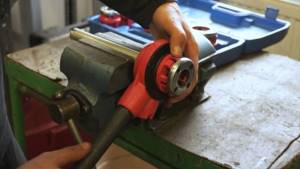
Experienced craftsmen always monitor the position of the clamp: it must be located strictly perpendicular to the pipe. In addition, they perform cutting by alternating a full turn forward and half a turn back. This is done to timely get rid of chips that prevent an even cut.
Even a perfectly executed thread does not ensure perfect joint integrity. Therefore, additional materials are always used to seal gas threaded connections.
Option No. 5 - flange connections
This method is suitable for pipes made of copper, steel, and polyethylene. Only used in low pressure areas.
A flange is a flat piece with holes made in it. The part itself serves as a connecting element. The holes in it are for studs and bolts.

It is necessary to select a flange taking into account the parameters specified in GOST 12820-80. The document takes into account the compliance of the nominal pressure of the gas pipeline and the standard size of the part
For PVC pipes, special fittings are used, which are connected by welding. In the case of metal elements, you can do without heating. They use bolts to secure the flanges.
Solvent-based sealants
This material is a drying paste. The simplest and most logical way to seal threaded connections. This sealant appeared on the Russian construction market relatively recently, and most often it is used in conjunction with flax, which affects the effectiveness of sealing.
Advantages of solvent based sealing materials:
- The paste dries already in the threaded gap, which prevents the possibility of squeezing the paste out of the joint.
- Thread lubrication, making installation easier.
- High level of fixation.
It is worth noting the disadvantages of this material, including:
- There is a need to tighten the connection.
- The sealant shrinks when fixing a large thread gap.
Copper soldering rules
If you need to solder a copper product or a product containing copper components, it is impossible to give a definite answer as to how and what is the best way to do this. The choice of method and tools depends on many factors, such as the size and weight of the parts, their composition. The load to which already soldered products must be subjected is also taken into account. There are several soldering methods, and it is better to know them all so that, if necessary, choose the most suitable one.
Soldering large parts
Scheme of capillary soldering of copper.
If you need to solder massive or large parts that cannot be heated to the required temperature with a soldering iron, a torch and copper solder are used. The flux in this case is borax. The strength of copper-phosphorus solder is higher than that of standard tin.
A thin layer of flux is applied to the mechanically stripped pipe or wire. After this, a fitting is put on the pipe, also mechanically cleaned. Using a gas torch, the joint is heated until the flux-coated copper changes color. The flux should become silver in color, after which you can add solder. The solder melts instantly and penetrates into the gap between the pipe and the fitting. When drops of solder begin to remain on the surface of the pipes, the solder is removed.
The pipes should not be overheated, as this will not promote a greater capillary effect. On the contrary, copper heated to blackness is less amenable to soldering. If the metal begins to turn black, heating should be stopped.
Soldering wires or wires
To solder thin copper wires, do not use zinc chloride solder as it will destroy the copper. If there is no flux available, you can dissolve an aspirin tablet in 10-20 ml of water.
Scheme of copper welding in an inert gas environment.
Copper wire or parts made of wire of various sections can be easily heated to the desired temperature using a soldering iron. The temperature regime should be the one at which the solder, tin or lead-tin, melts, and this is what soldering is done with. Fluxes must contain rosin or be made on its basis; solder oil or even rosin itself can be used.
The surface of the wire is cleaned of dirt and oxide film, after which the parts are tinned. This process involves applying a thin layer of flux or rosin to heated copper, and then solder, which is distributed over the surface as evenly as possible using a soldering iron. The parts requiring connection are connected and heated again with a soldering iron until the already solidified solder begins to melt again. When this happens, the soldering iron is removed and the connection cools.
The parts can be clamped in a vice so that the distance between them is 1-2 mm. Flux is applied to the parts and heated. Solder is brought to the gap between the hot parts, which will melt and fill the gap. The melting point of solder for soldering using this method must be lower than the melting point of copper so that the parts do not become deformed. The part cools, then it is washed with water and, if necessary, sanded with sandpaper until smooth and uniform.
Soldering utensils or soldering holes in copper
When soldering dishes, they use pure tin, the melting point of which is higher than that of tin or lead-containing solder. Sometimes, to solder large parts, hammer soldering irons are used, heated over an open fire with a gas burner or blowtorch. In the future, everything happens according to the standard scheme: stripping, flux and tinning, joining parts and heating with a soldering iron. It is for this soldering iron that pure tin solder is convenient.
On the inside, the fitting usually has a border that prevents it from being threaded through the pipe. It can be removed using a coarse file if the fitting needs to be pushed onto the pipe further than intended and thus soldering an unnecessary hole.
Fluoroplastic tapes (FUM)
This thin film has currently gained great popularity in our country, and a couple of decades ago it was almost impossible to find it on our market.
The advantages of FUM tape include chemical resistance and ease of installation. PTFE tape has a number of disadvantages. For example, it does not provide a high level of sealing and is likely to jump out of the threaded connection in the event of a change in temperature with all the ensuing consequences. Poor sealing of joints subject to vibration, poor sealing of joints larger than ¾ inch in diameter, and poor sealing properties on high quality threads.
Characteristics
Sealing lubricants are divided into 3 types:
- Reinforcement.
- Threaded.
- Vacuum.
Reinforcement lubricants are intended for sealing fittings of gas mains, distribution stations, taps and threaded connections. Lubricants “For gas taps” are widely used, which include:
- base - castor oil;
- thickener - calcium soap.
There is also a more heat-resistant composition used for sealing shut-off devices in oil and gas fields - Armatol-238. It includes:
- base - emulsion of castor and synthetic oils;
- thickener - aerosil;
- graphite.
Lubricants have parameters (using the example of Armatol-238):
- Dropping point - shows the melting temperature of the thickener and the disruption of its structure, after which drop formation begins (160°C).
- Penetration indicator - reflects the thickness of the lubricant. It is equal to the number of mm of immersion of the measuring device cone, multiplied by 10 (10-1 at 25°C).
- Shear strength is the load at which irreversible disruption of the frame bonds occurs (up to 150 Pa).
- Viscosity - shows losses due to internal friction (less than 150 Pa-s at 0°C).
- Colloidal stability - the degree of release of oil from a lubricant under the influence of external forces and temperature (up to 15%).
- Corrosion stability - the ability to cause metal corrosion (—).
- Water content (up to 0.5%).
Also in lubricants, the degree of solubility in various chemical compounds, the content of foreign impurities, and main components are determined.
Thread lubricants are intended for sealing joint joints of pipes of pumping and compressor equipment, gas condensate wells. In industry, the use of the P-402 composition is widespread, which includes:
- petroleum oils;
- organosilicon compounds;
- thickeners in the form of lithium and aluminum stearates;
- graphite, zinc, copper, lead.
Thread compound is characterized by increased heat resistance (-50...200C), low moisture content (up to 0.1%).
If it is necessary to create a vacuum environment, use vacuum lubricants. They are unstable and can only be used at temperatures of -10...40°C, but they are distinguished by high water resistance and preservation characteristics.
Storing gas equipment in a warehouse involves the use of lubricants: gun lubricant (GOST 19537-83), as well as conservation oil (GOST 18974-73). In addition to purchased lubricants, they use compositions made from heated instrument oil and paraffin crumbs dissolved in it, as well as from wax, turpentine and anhydrous fat.
Universal sealing thread.
This tape is made from nylon and impregnated with a special compound. The most popular of them are the threads “Unilok” (produced in the European Union) and “Record”, produced in Russia.
Advantages of a universal thread:
- Ease of use
- The most advanced method of sealing threaded connections in our time.
- Low cost.
- High connection reliability.
- Withstands temperatures up to 130 degrees Celsius.
- Perfectly seals the gas pipeline.
- Possibility of installation at low temperatures or on wet surfaces (other types of sealants cannot be used in such conditions).
Disadvantages of universal thread:
- Cannot be used when installing an oil pipeline.
- Not the most reliable sealing of large diameter pipes.
- The need for roughness on the thread.
The universal sealing thread has almost no disadvantages and has a relatively low price, so this method of sealing can be called optimal.
Composition and capacity
Lubricants for industrial gas equipment include a liquid base and a thickener. The basis is:
- glycerol;
- petroleum oils;
- synthetic compounds.
Thickeners for compositions are salts of high molecular weight fatty acids or “soaps”.
To increase heat resistance and tightness, additives are included in the lubricant:
- mica;
- graphite;
- molybdenum;
- fluoroplastic chips and other components.
You can purchase lubricant in mini-packages or large containers. For example, Molykote 1102 is available for single use (50 g, 12 pieces per package), in containers weighing 1 kg and 25 kg.
The compositions are applied with a brush, spatula, gun, or using automatic equipment.
Anaerobic adhesives and sealants
This material has good viscosity and liquid consistency. They can remain outdoors for a long time without changing their properties. When they enter threaded connections where there is no air, they polymerize without shrinkage. The result is a very strong and hard substance, similar in properties to plastic. It provides excellent sealing and completely fills the gap in the thread, regardless of the pressure of the liquid or gas in the pipes. An important advantage of anaerobic adhesives is that they turn into a solid substance only in threaded connections, and in the open air they retain a liquid form and do not clog equipment and valves. They can be easily removed from the surface. This material is widely used in industry.
Anaerobic adhesives can be easily applied straight from the package. When carrying out large-scale work, it is worth using dispensers. Different types of adhesives have different polymerization times for the substance, from 3 minutes to several hours. The choice of a specific adhesive depends on the technical task. If you need quick installation, then you should use glue with a short hardening time. In a situation where the connection needs to be adjusted, then you can choose an adhesive that takes on its final shape after some time.
A connection sealed with anaerobic glue can be disassembled using ordinary tools. After hardening, the glue is non-toxic, which allows it to be used in the food industry. The operating temperature of anaerobic sealants ranges from -55 to +150 degrees Celsius. Some types of glue can withstand up to +200 degrees. When briefly exposed to higher temperatures, they can continue to do their job without changing properties. The cost of anaerobic adhesives is higher than other types of sealants. However, they fully honor the advertised price. The reliability of the connection using anaerobic glue is much higher than that of any other material. Each owner chooses for himself what is more important to him: confidence and reliability or the likelihood of large losses in the event of a system failure.
The undoubted advantages of anaerobic adhesive-sealant include ease of use, thread sealing regardless of force, easy installation of the system due to its lubricating properties, the ability to withstand greater gas or liquid pressure, better price-quality ratio, and retention of liquid form in the open air.
The disadvantages of this substance include the inability to use it in oxidizing and oxygen environments and at low temperatures due to an increase in polymerization time. This composition can only be used on dry threads and is not recommended when installing pipes with a diameter larger than M80.
Features of connecting gas pipes
For a long time, the gas pipeline consisted exclusively of metal pipes of different diameters. The material was valued for its ability to create a seamless pipeline capable of maintaining absolute tightness under high pressure.
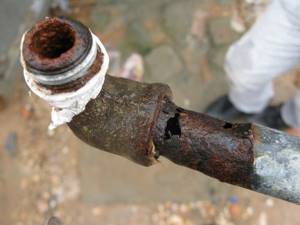
Connections of rusted metal pipes are a source of increased danger, since it is at the joints that the steel alloy is destroyed especially quickly
The significant drawback of the metal alloy forced us to look for other options - under the influence of moisture, after several years of operation, it began to rust, threatening the integrity of the pipeline.
Then pipes from other materials began to appear:
- Copper , the advantage of which is considered resistance to corrosion, the disadvantage is the ability to maintain integrity at low pressure not exceeding 5 kPa.
- Low carbon steel , not susceptible to rust. Its disadvantage is difficulty in processing and high cost. Therefore, for the construction of gas pipelines, PVC pipes with a steel outer braid are used.
- Polyethylene . Elastic and lightweight, this material does not conduct electricity, is cheaper than other analogs and can withstand strong transformations without losing integrity.
You can read more about the different types of gas pipes and the features of their choice in this material.
The elements connecting the main line and the branch leading to the consumer began to be made of rubber. For such connections, heat-resistant rubber is selected that is not prone to drying out due to excessive insolation.
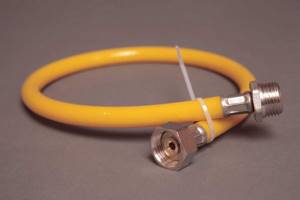
When installing rubber connections, finished factory products are used. Flexible eyeliners made in artisanal conditions do not comply with safety regulations
The choice of material is determined by the pressure in the gas pipeline, the required throughput and is calculated by specialists.
The same goes for connections. Only a professional can determine the appropriate type of fastening and correctly correlate it with the pipe material and technical operating conditions.
How to fix a gas leak yourself
Of all possible breakdowns in utility networks, gas leakage is the most dangerous malfunction, therefore the slightest problems in the gas supply must be eliminated immediately. Of course, it is better to entrust the repair of gas equipment to specialists, but in some cases you have to solve problems yourself. Most often, gas leaks occur in connections. If you have a simple tool and some components, most of us can easily fix such a breakdown ourselves. To do this you will need: a gas wrench, a soap solution, a flexible gas connection, paranitic gaskets or fum tape. The first sign of a gas leak is the appearance of a characteristic odor in the room. To eliminate it, step-by-step actions will be required, sometimes it is necessary to replace only flexible metal hoses, and sometimes more serious intervention is required.
Step 1.
It is necessary to determine the exact location of the leak. To do this, all gas appliances and connections must be checked. This is very simple to do: all joints of pipes, connections, and ball valves must be covered with soapy water. If there is a leak, air bubbles will appear at the weak point. The procedure for checking a gas water heater or boiler is slightly different. First you need to turn off the gas supply and ventilate the room well. After this, open the valve and turn on the burner. If the flame that appears is larger than usual, this means that there is a leak in the combustion chamber and the gas appliance needs to be repaired. Gas equipment must be repaired in specialized service centers.
Step 2.
Having determined the cause and location of the leak, you can begin to eliminate it. To do this, close the gas supply valve, after which the problematic connection is unscrewed and repacked. If the cause of the leak is in the gas line, it must be replaced, since the lines cannot be repaired. When installing it, do not twist it so as not to damage it. To do this, you will need an additional wrench that holds the hose itself while another wrench clamps the union nut.
Step 3.
After eliminating the cause of the leak, the entire system must be checked again for leaks. To do this, it is necessary to re-apply a soap solution to all connections, and if leaks are no longer detected, a control test of the performance of gas appliances can be carried out. If the devices operate stably and there is no smell of gas, then the system is sealed and fully operational.
Related publications:
- Sealing sewer pipe joints
- Installation of gas pipes in the apartment
- How to connect gas pipes
- Installation of cast iron sewer pipes
- Laying gas pipes underground
- Cast iron pipe repair
Ochepyatka! “The notches are applied to the threads using a soldering iron.” Not a plumber, however, I believe he meant a FILE. At first I was stunned by this phrase, until I googled “notches” and saw a file in another article.
Well, guess what, you wanted to correct a typo, but you yourself typed it)))
Thank you! I found how to quickly and with what to replace the sealant for a gas pipe.




